Clinical Implications:
Maryland Bridge can be a conservative and good esthetic treatment option for patients who are in their growing age and want only fix prosthesis. Proper patient selection and skillfull tooth preparation result in a long lasting, esthetic and functional prosthesis .
Introduction:
In young patients, pulp chambers are large and preparation of teeth for complete veneer retainers may cause injury to the pulp and lead to hypersensitivity or pulpal damage. To delay this line of treatment an immediate replacement with minimum preparation should be taken up as a treatment of choice for younger patients. One way to replace a tooth is the Maryland bridge. This bridge technique was first developed at the University of Maryland, and this is where it gets the name. A Maryland bridge consists of a metal framework with a porcelain tooth baked on to the front of the framework. The framework then ends up as a false tooth with two metal wings on the side. These metal wings are prepared to have a porous surface so that they can receive a bonding agent, and then the wings are bonded to the back sides of the teeth on either side of the missing tooth.[1],[2]
Case Report:
A 14 years male patient (Fig.1), reported to the department of Prosthodontics with chief complaint of poor looks due to a missing front tooth on recording detailed history of the patient , it was known that the patient met with an road traffic accident four years back which led to loss of his right central incisor .The patient insisted for the fixed prosthesis only and therefore he was not willing for any treatment partial or cast partial denture . Implant as a treatment option was also ruled out keeping in view the growing age of the patient.On radiographic examination , it was evident that the pulp chambers of the abutment teeth i.e. of 12 and 21 were large. Looking into all these aspects it was decided to manage the case with Maryland Bridge. The patient was convinced and reassured regarding the success of the type of treatment and prosthesis which will be made.
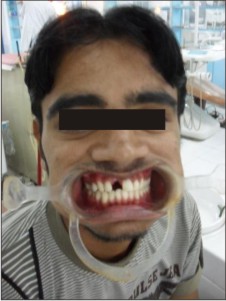 | Fig : 1
 |
Tooth preparation was done on the palatal aspect of 12 and 21 , Carefull minimal reduction was done , finish line was given chamfer margin , three retentive grooves were made on the palatal aspect of abutments . Final finishing of the preparations were done , impression were made with putty reline technique . Working cast obtained , wax pattern made (Fig. 2) , sprue attached , casting was done , metal framework obtained (Fig. 3) and tried in the patient (Fig.4).
Finally the prosthesis was ready (Fig. 5) and cemented in the patient (Fig. 6) with resin cement . The patient was happy with the prosthesis as remarkably good esthetics was obtained .
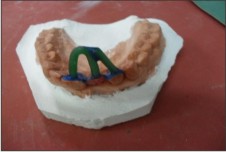 | Fig : 2
 |
 | Fig : 3
 |
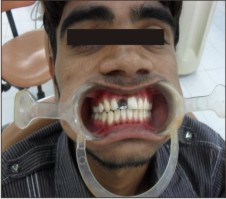 | Fig : 4
 |
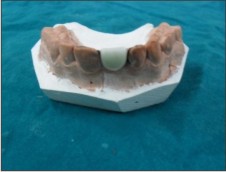 | Fig : 5
 |
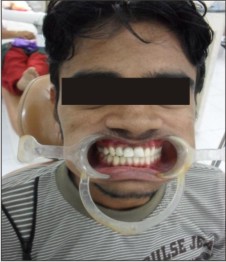 | Fig : 6
 |
Discussion
Etched, cast, resin-bonded fixed partial dentures were first developed at the University of Maryland Dental School in 1980.The advantages of bonded cast restorations include (1) minimal tooth reduction without dentinal or pulpal involvement, (2) avoidance of
anesthetics or gingival displacement cords, (3) use of relatively reversible procedures, (4) use of thin, highly polished supragingival retainers, (5) potential for improved esthetics, and (6) reduced fees. Despite acceptance, there are limitations to the use of resin-bonded restorations.
They are not indicated for long-span FPD or when abutments have large restorations, extensive caries, short clinical crowns, or extensive abrasion, erosion, or wear. There are several disadvantages to resin-bonded prostheses. The restoration cannot be temporarily cemented like conventional FPD; therefore there is no trial period to evaluate occlusion, contour, or esthetics, and the retainer is slightly overcontoured to resist flexure of the metal. Despite these limitations and disadvantages, this method of treatment has become popular[3].
In today’s dental practice a missing tooth in the anterior region of mouth is not only a physical loss, but also an emotional experience for the patient as well. Replacing a congenitally missing tooth or a tooth lost by decay, trauma, root fracture or failed root canal treatment need a conservative and reasonable treatment option[4]. Many treatment modalities are available for replacing a single missing tooth such as removable partial denture, fixed partial denture or dental implant but each modality has its own advantages and disadvantages. For the success of prostheses patient awareness is very important for treatment planning , hence it is one of the most challenging restorations in dentistry. Satisfaction with RPDs depends upon technical and patient-related variables[5].
For the acceptance of prosthesis comfort, masticatory ability, esthetics, and retention seem to be the most important factors . The traditional treatment for a single edentulous space is a conventional fixed partial denture. A major drawback of this alternative is the significant tooth reduction of the abutments. The use of fixed partial denture should be avoided in young patients because the rigid fixed partial denture could interfere with jaw growth. Even after a decade of service the periodontal response for resin bonded fixed partial dentures is minimal. The three most common complications associated with resin-bonded prosthesis are debonding , tooth discoloration and caries . The implication of interim prosthesis for young patients can serve as a shelter from invasive procedure like fixed partial denture and implants in growing patients[6],[7],[8].
Conclusion
Caries and trauma remained the most common cause of replcement of missing teeth. As these are the most common modes of loss of teeth in adoloscent patients Resin bonded bridge’s may be proposed as a suitable treatment modality especially in patients who are mindful of aesthetics and are not amenable to removable options.
References
1. Terry Donovan DDS , The procera maryland bridge: a case report , Journal of esthetic and restorative dentistry : volume 20 : 3 , 172-3 .
2. Sabita M. Ram, Deshpande P, Rubina. The zirconia resin bonded prosthesis: A case report. Dental practice. 2010; 9(2): 12-14.
3. Livaditis GJ, Thompson VP. Etched castings: an improved retentive mechanism for resin bonded retainers. J Prosthet Dent 1982;47:52-8.
4. Rubinstein S, Nidetz AJ, Hoshi M, A Multidisciplinary Approach to Single-ToothReplacement. QDT 2004: 1-19.
5. Al-Quran A, Al-Ghalayini FR, Al-Zubi BN. Singletooth replacement: factors affecting different prosthetic treatment modalities. Oral Health 2011;11(34): 1-7.
6. Cosme DC, Baldisserotto SM, Fernandes EDL, Rivaldo EDL, Rosing CK, Shinkai RSA. Functional evaluation of oral rehabilitation with Removable partial dentures after five years. Journal of Applied Oral Sciences 2006; 14(2):111-116.
7. Goodacre CJ, Bernal G, Rungcharassaeng K, YK Kan J. Clinical complications in fixed prosthodontics. The Journal Of Prosthetic Dentistry 2003; 90:31-41.
8. Livaditis G: Cast metal resin-bonded retainers for posterior teeth, J Am Dent Assoc101:926, 1980.
|